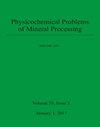HPGR 和圆锥破碎机辅助球磨机研磨的定量研究:通过评估 HPGR 技术和圆锥破碎机可能产生的微裂缝效应建立数学模型
IF 1.2
4区 工程技术
Q2 Earth and Planetary Sciences
引用次数: 0
摘要
高压辊磨机(HPGR)在采矿业的应用已有几十年的历史。然而,对粉碎后颗粒特性的量化研究十分有限。此外,该技术在碾磨过程中产生的微裂缝的影响也未得到广泛量化。在最近的工作中,测试了两种粉碎路径:1(颚式破碎机 + 圆锥破碎机 + 球磨机)和 2(颚式破碎机 + HPGR + 球磨机)。通过比能量、细粒生成量和破碎率测量,显示了 HPGR 路径的微裂缝可能对球磨机研磨产生的削弱作用。为了量化微裂缝的影响和 HPGR 技术的高破碎率,首先使用 Rosin Rammler 的 Weibull 双公式对产品进行了重构,并通过传统圆锥破碎机获得了类似的粒度分布。这样,无论采用哪种破碎工艺(HPGR 或圆锥破碎机),研磨阶段的给料粒度分布都保持不变。结果表明,HPGR 技术产生的微裂缝会影响具体能耗、细粒生成和破碎率。HPGR 后的球磨机消耗的特定能量为 12.46 kWh/t,而圆锥破碎机后的球磨机消耗的特定能量为 14.36 kWh/t。本文提出的实验方法保持了一致的进料粒度范围(-1500 至 +41.31 µm),以表明在进行 HPGR 研磨的样品中观察到的粒度降低并不是导致能耗降低和细粒生成增加的主要因素。相反,它主要与 HPGR 技术中通过压缩产生的微裂缝有关;研究显示了碾磨路径的能耗降低(优化)情况。本文章由计算机程序翻译,如有差异,请以英文原文为准。
A quantitative study between HPGR and cone crusher aided ball mill grinding: mathematical modeling by evaluating the possible microfracture effect produced by HPGR technology and cone crusher
High Pressure Grinding Rolls (HPGR) have been used in the mining industry for decades. However, there are limited quantifications of the particle properties after comminution. Furthermore, the influence of microcracks in grinding provided by this technology has not been extensively quantified. In the recent work, there were two comminution paths tested: 1 (Jaw crusher + cone crusher + ball mill) and 2 (Jaw crusher + HPGR + ball mill). The possible weakening effect aiding ball mill grinding due to microcracks of HPGR path was shown via specific energy, fines generation and breakage rate measurements. To achieve a quantification about the impact of microcracks and the high rate of reduction rate of HPGR technology, first the product was reconstructed using Rosin Rammler's Weibull double formula and the similar particle size distribution was obtained by a conventional cone crusher. By this way the feed size distribution to the grinding stage remained constant regardless of the type of crushing process (HPGR or cone crusher). The results showed that the microfractures generated by the HPGR technology influence the specific energy consumption, fines generation and breakage rates. Ball mill after HPGR consumed 12.46 kWh/t of specific energy, however ball mill after cone crusher consumed 14.36 kWh/t of specific energy. The experimental methodology proposed in this paper maintains a consistent feed size range (-1500 to +41.31 µm) to show that the size reduction observed in the sample undergoing HPGR grinding is not the primary factor contributing to reduced energy consumption and increased fines generation. Instead, it is predominantly associated with the microfractures generated through the compression in HPGR technology; the energy reduction (optimization) of a grinding path is shown in the study.
求助全文
通过发布文献求助,成功后即可免费获取论文全文。
去求助
来源期刊

Physicochemical Problems of Mineral Processing
工程技术-矿业与矿物加工
CiteScore
2.20
自引率
6.70%
发文量
99
审稿时长
3.3 months
期刊介绍:
Physicochemical Problems of Mineral Processing is an international, open access journal which covers theoretical approaches and their practical applications in all aspects of mineral processing and extractive metallurgy.
Criteria for publication in the Physicochemical Problems of Mineral Processing journal are novelty, quality and current interest. Manuscripts which only make routine use of minor extensions to well established methodologies are not appropriate for the journal.
Topics of interest
Analytical techniques and applied mineralogy
Computer applications
Comminution, classification and sorting
Froth flotation
Solid-liquid separation
Gravity concentration
Magnetic and electric separation
Hydro and biohydrometallurgy
Extractive metallurgy
Recycling and mineral wastes
Environmental aspects of mineral processing
and other mineral processing related subjects.
 求助内容:
求助内容: 应助结果提醒方式:
应助结果提醒方式:


